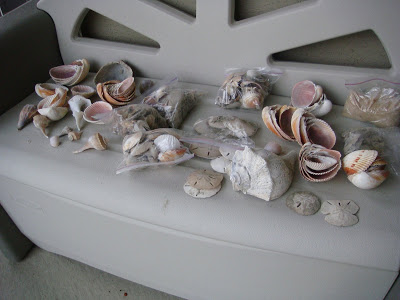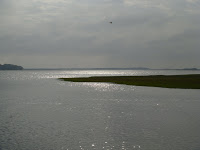 It was foggy and half-light when Chris and I left Jacksonville Saturday morning. We looped around 9A to I-95 north up to Georgia, our favorite haunt of recent weekends. We arrived in historic St. Mary just in time to catch the Cumberland Lady, the 45-minute ferry ride to Cumberland Island. The boat was full, mostly of campers and beach-goers decked out with coolers.
It was foggy and half-light when Chris and I left Jacksonville Saturday morning. We looped around 9A to I-95 north up to Georgia, our favorite haunt of recent weekends. We arrived in historic St. Mary just in time to catch the Cumberland Lady, the 45-minute ferry ride to Cumberland Island. The boat was full, mostly of campers and beach-goers decked out with coolers.
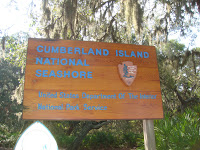 We skipped the Dungeness Dock in favor of the Sea Camp Dock where I could get a stamp of the outline of the island in my National Park Passport. Yay! Then we hiked down the River Trail between live oaks, Spanish bayonet, Spanish moss and many, many spiderwebs.
We skipped the Dungeness Dock in favor of the Sea Camp Dock where I could get a stamp of the outline of the island in my National Park Passport. Yay! Then we hiked down the River Trail between live oaks, Spanish bayonet, Spanish moss and many, many spiderwebs.
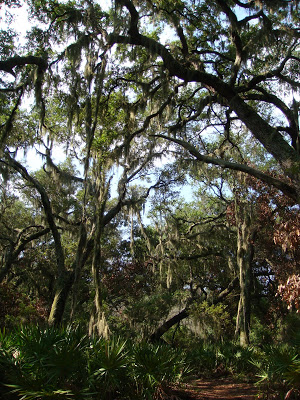
The Dungeness Dock sits next to an open field that the wild horses of the island keep short. On of the horses followed Chris around, inciting squeals of jealousy from a chubby little girl there with her family. It’s fun being a big kid so adults can’t tell you not to do what they’re telling their own kids not to do. Mama and Daddy let us jump off of and climb things most kids weren’t, and those kids’ parents always felt a need to boss us around when M&D were out of range, so we’d just wait for them to leave and get back to the jumping or whatever. But now, bwa ha ha, Chris can pet the wild horses if he wants to while parents hold their children at bay, most likely annoyed it did not bite him so they could teach it into a lesson of what happens when you don’t follow the rules. Take that, rules!
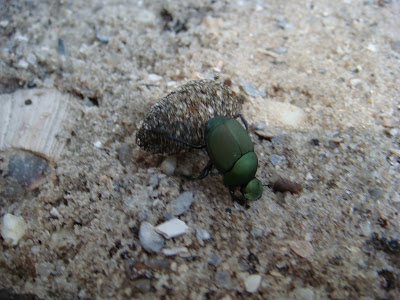 A live oak-lined, unpaved avenue drifts toward Dungeness from the dock. Chris astutely noticed a gen-u-wine dung beetle pushing his smelly load across the road.
A live oak-lined, unpaved avenue drifts toward Dungeness from the dock. Chris astutely noticed a gen-u-wine dung beetle pushing his smelly load across the road.
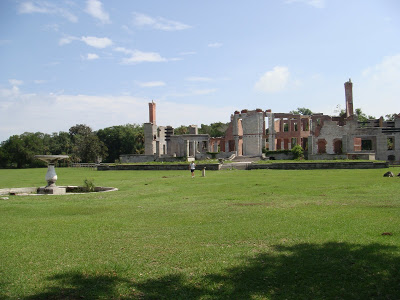
This is Dungeness from the back. The Spanish lived on the island (then called San Pedro) from 1670 to 1724.
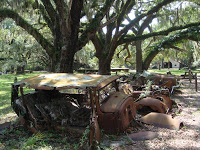 General James Oglethorpe renamed Cumberland Island and the English established a hunting lodge named Dungeness before abandoning it in 1775. Oglethorpe was the leader of last weekend’s GA locale 30 miles north: Fort Frederica on St. Simons Island. In 1796, Phineas Miller began work on Dungeness Mansion near the old hunting lodge. The mansion held Georgia’s high-society parties until it was occupied by the British during the War of 1812. The island was mostly abandoned after the Civil War and Dungeness burnt to the ground in 1866. Thomas Carnegie bought land in 1880
General James Oglethorpe renamed Cumberland Island and the English established a hunting lodge named Dungeness before abandoning it in 1775. Oglethorpe was the leader of last weekend’s GA locale 30 miles north: Fort Frederica on St. Simons Island. In 1796, Phineas Miller began work on Dungeness Mansion near the old hunting lodge. The mansion held Georgia’s high-society parties until it was occupied by the British during the War of 1812. The island was mostly abandoned after the Civil War and Dungeness burnt to the ground in 1866. Thomas Carnegie bought land in 1880 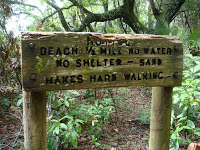 and rebuilt the 59-room castle of Dungeness that is in ruins today (no one lived there when it burnt in 1959). The Carnegie family donated it as a national seashore in 1972 to keep the guy who developed Hilton Head from creating a duplication on Cumberland Island. The park ensures only 300 people are allowed on the island at a time, so sea-shelling is excellent and even encouraged.
and rebuilt the 59-room castle of Dungeness that is in ruins today (no one lived there when it burnt in 1959). The Carnegie family donated it as a national seashore in 1972 to keep the guy who developed Hilton Head from creating a duplication on Cumberland Island. The park ensures only 300 people are allowed on the island at a time, so sea-shelling is excellent and even encouraged.
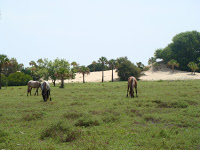 That’s why Chris and I were there early with a packed lunch and extra baggies. We passed the dung beetle and a sloooooooow-moving tour group, circled the Dungeness ruins and explored the cemetery. It’s depressing to see the degradation of such an expensive home. The owner of such a house should care for it and take pride in it, not abandon it and pay someone to set it on fire for insurance money (rumor). A plaque shows a photo of a wedding at the house, and it has deteriorated to this. Blah. What a waste. And the cemetery contained som
That’s why Chris and I were there early with a packed lunch and extra baggies. We passed the dung beetle and a sloooooooow-moving tour group, circled the Dungeness ruins and explored the cemetery. It’s depressing to see the degradation of such an expensive home. The owner of such a house should care for it and take pride in it, not abandon it and pay someone to set it on fire for insurance money (rumor). A plaque shows a photo of a wedding at the house, and it has deteriorated to this. Blah. What a waste. And the cemetery contained som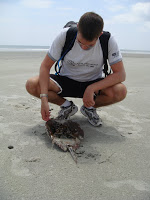 e of the Carnegie family members, as well as General Robert E. Lee’s dad’s original grave, although his body was relocated to Virginia. A tiny grave for a three-year-old sat alone in the corner of the cemetery. Knowing Chris and I will move all over, I wonder what we’d do if we had a child die far from home. It would break my heart to be on my death bed decades from now, knowing that one of our babies was all by its lonesome in Asia instead of at least being nestled snugly among family. I know that’s silly; in that situation I’d be looking forward to seeing my baby again and Mama would probably be taking good care of her when I got to Heaven anyway, but it’s still sad to see that little granite marker all alone.
e of the Carnegie family members, as well as General Robert E. Lee’s dad’s original grave, although his body was relocated to Virginia. A tiny grave for a three-year-old sat alone in the corner of the cemetery. Knowing Chris and I will move all over, I wonder what we’d do if we had a child die far from home. It would break my heart to be on my death bed decades from now, knowing that one of our babies was all by its lonesome in Asia instead of at least being nestled snugly among family. I know that’s silly; in that situation I’d be looking forward to seeing my baby again and Mama would probably be taking good care of her when I got to Heaven anyway, but it’s still sad to see that little granite marker all alone. Anywho, we finally got out to the beach and progressed south, toward the jetty where the good shells were, so sayeth the park ranger. Chris would not let me take any horseshoe crabs home even though we saw a lot and they were the biggest shells we found. But I guess they wouldn’t really look that nice on my seashelf…
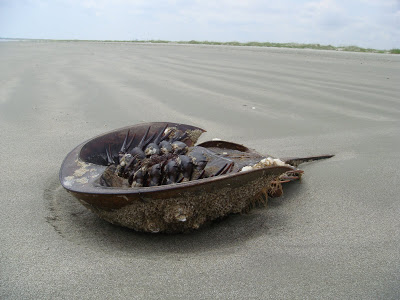 Once we got to the jetty I realised I’d pictured The Jetty as this magical land of enormous shells walking themselves out of the ocean and presenting themselves to me. That was not in fact the case. We checked the time and were shocked that we only had an hour until the ferry left. How had we used up more than six hours??!!? And now we were tired and laden down with many, many seashells. If you miss the ferry, you, ah, miss the boat. Good thing we brought Off!
Once we got to the jetty I realised I’d pictured The Jetty as this magical land of enormous shells walking themselves out of the ocean and presenting themselves to me. That was not in fact the case. We checked the time and were shocked that we only had an hour until the ferry left. How had we used up more than six hours??!!? And now we were tired and laden down with many, many seashells. If you miss the ferry, you, ah, miss the boat. Good thing we brought Off!
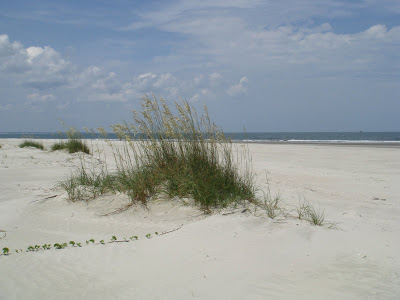 We walked veeeeeery quickly back up the several miles of beach. We walked right along the water so as not to be
We walked veeeeeery quickly back up the several miles of beach. We walked right along the water so as not to be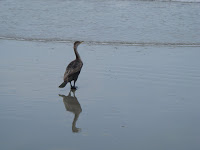 tempted by the littering of shells at the water lines. We found tons of freshly-dead sand dollars and starfish but no more shells. Considering we were sunburned and had been walking all day, we were amazed we made it back in time to catch the ferry. We’d run out of water before the jetty, so that was one barren walk back. We didn’t even have time to go swimming! We were covered in sand and grit and we both have very terrible tan lines now, but oh boy! did we get the mother load of seashells! I still can’t believe how sore my legs are just from walking, but we had pretty great weather considering it rained all day in Jacksonville.
tempted by the littering of shells at the water lines. We found tons of freshly-dead sand dollars and starfish but no more shells. Considering we were sunburned and had been walking all day, we were amazed we made it back in time to catch the ferry. We’d run out of water before the jetty, so that was one barren walk back. We didn’t even have time to go swimming! We were covered in sand and grit and we both have very terrible tan lines now, but oh boy! did we get the mother load of seashells! I still can’t believe how sore my legs are just from walking, but we had pretty great weather considering it rained all day in Jacksonville. 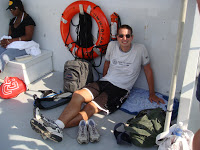 Chris was mostly shelling up by the dunes, where he found several big swirly shells and huge clam shells. I found some pretty swirly shells, too, and one HUGE one—it was poking out of the sand above the waterlines I was walking, and I thought, “No way is that whole, but I better check.” It WAS in fact whole, just a little mottled, but ENORMOUS! We also found those shiny olive shells like we found in abundance in Pensacola, but those were all pink and these were dark and tortoise-shell colored. Really pretty, and some big ones, too! We also found a fair number of the marble-sized and larger shark eyes. Observe our multitude of loot and be amazed:
Chris was mostly shelling up by the dunes, where he found several big swirly shells and huge clam shells. I found some pretty swirly shells, too, and one HUGE one—it was poking out of the sand above the waterlines I was walking, and I thought, “No way is that whole, but I better check.” It WAS in fact whole, just a little mottled, but ENORMOUS! We also found those shiny olive shells like we found in abundance in Pensacola, but those were all pink and these were dark and tortoise-shell colored. Really pretty, and some big ones, too! We also found a fair number of the marble-sized and larger shark eyes. Observe our multitude of loot and be amazed:

